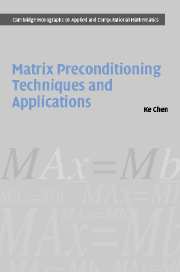Book contents
- Frontmatter
- Contents
- Preface
- Nomenclature
- 1 Introduction
- 2 Direct methods
- 3 Iterative methods
- 4 Matrix splitting preconditioners [T1]: direct approximation of An×n
- 5 Approximate inverse preconditioners [T2]: direct approximation of An×n−1
- 6 Multilevel methods and preconditioners [T3]: coarse grid approximation
- 7 Multilevel recursive Schur complements preconditioners [T4]
- 8 Sparse wavelet preconditioners [T5]: approximation of Ãn×n and Ãn×n−1
- 9 Wavelet Schur preconditioners [T6]
- 10 Implicit wavelet preconditioners [T7]
- 11 Application I: acoustic scattering modelling
- 12 Application II: coupled matrix problems
- 13 Application III: image restoration and inverse problems
- 14 Application IV: voltage stability in electrical power systems
- 15 Parallel computing by examples
- Appendix A a brief guide to linear algebra
- Appendix B the Harwell–Boeing (HB) data format
- Appendix C a brief guide to MATLAB®
- Appendix D list of supplied M-files and programs
- Appendix E list of selected scientific resources on Internet
- References
- Author Index
- Subject Index
- Plate section
8 - Sparse wavelet preconditioners [T5]: approximation of Ãn×n and Ãn×n−1
Published online by Cambridge University Press: 06 January 2010
- Frontmatter
- Contents
- Preface
- Nomenclature
- 1 Introduction
- 2 Direct methods
- 3 Iterative methods
- 4 Matrix splitting preconditioners [T1]: direct approximation of An×n
- 5 Approximate inverse preconditioners [T2]: direct approximation of An×n−1
- 6 Multilevel methods and preconditioners [T3]: coarse grid approximation
- 7 Multilevel recursive Schur complements preconditioners [T4]
- 8 Sparse wavelet preconditioners [T5]: approximation of Ãn×n and Ãn×n−1
- 9 Wavelet Schur preconditioners [T6]
- 10 Implicit wavelet preconditioners [T7]
- 11 Application I: acoustic scattering modelling
- 12 Application II: coupled matrix problems
- 13 Application III: image restoration and inverse problems
- 14 Application IV: voltage stability in electrical power systems
- 15 Parallel computing by examples
- Appendix A a brief guide to linear algebra
- Appendix B the Harwell–Boeing (HB) data format
- Appendix C a brief guide to MATLAB®
- Appendix D list of supplied M-files and programs
- Appendix E list of selected scientific resources on Internet
- References
- Author Index
- Subject Index
- Plate section
Summary
The subject of “wavelets” is expanding at such a tremendous rate that it is impossible to give, within these few pages, a complete introduction to all aspects of its theory.
Ronald A. Devore and Bradley J. Lucier. Wavelets. Acta Numerica (1992)If A is a bounded operator with a bounded inverse, then A maps any orthogonal basis to a Riesz basis. Moreover, all Riesz bases can be obtained as such images of an orthogonal basis. In a way, Riesz bases are the next best thing to an orthogonal basis.
Ingrid Daubechies. Ten Lectures on Wavelets. SIAM Publications (1992)The discovery of wavelets is usually described as one of the most important advances in mathematics in the twentieth century as a result of joint efforts of pure and applied mathematicians. Through the powerful compression property, wavelets have satisfactorily solved many important problems in applied mathematics, such as signal and image processing; see [269, 166, 441, 509] for a summary. There remain many mathematical problems to be tackled before wavelets can be used for solution of differential and integral equations in a general setting.
In this chapter, we aim to give an introduction to wavelet preconditioning and focus more on discrete wavelets. As far as the solution of operator equations is concerned, the construction of compactly supported and computable wavelet functions remains a challenge for the future. We discuss these issues in the following.
- Type
- Chapter
- Information
- Matrix Preconditioning Techniques and Applications , pp. 310 - 339Publisher: Cambridge University PressPrint publication year: 2005

